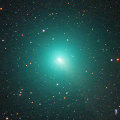
|
Now it is 4.6 mag (Oct. 18, Juan Jose Gonzalez). Very large, double of the full moon. Very bright and visible with naked eyes. It is approaching to the earth down to 0.12 A.U. In the Northern Hemisphere, it keeps observable all through this apparition until 2011 June when it fades down to 17 mag. In the Southern Hemisphere, it becomes unobservable temporarily from late September to mid October. But then it keeps observable in good condition.
Date(TT) R.A. (2000) Decl. Delta r Elong. m1 Best Time(A, h)
Oct. 16 4 26.97 49 19.8 0.125 1.072 124 5.4 2:47 (180, 75)
Oct. 23 5 54.16 33 42.3 0.122 1.061 120 5.1 3:48 ( 0, 89)
|

|
It has kept bright as 8.5 mag since July until September. It is still bright as 9.6 mag (Oct. 18, Juan Jose Gonzalez). It will be fading after this, but it will be visible visually until December.
Date(TT) R.A. (2000) Decl. Delta r Elong. m1 Best Time(A, h)
Oct. 16 1 17.78 -19 58.7 0.826 1.766 151 11.2 23:37 ( 0, 35)
Oct. 23 1 13.27 -19 23.3 0.883 1.806 148 11.5 23:05 ( 0, 36)
|

|
Paul Camilleri reported that it was not visible, fainter than 14-15 mag, on Sept. 29. Hidetaka Sato reported that it was not visible on Oct. 8, the nuclear magnitude must be fainter than 18 mag. It was expected to be bright as 13 mag still now, but actually, it seems to have been already disintegrated. Hirohisa Sato reported that it kept visible in the SWAN images until Sept. 6.
Date(TT) R.A. (2000) Decl. Delta r Elong. m1 Best Time(A, h)
Oct. 16 11 8.99 -52 43.3 2.592 2.123 51 12.5 4:42 (323,-18)
Oct. 23 11 20.46 -56 7.9 2.674 2.227 53 12.8 4:47 (327,-17)
|
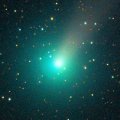
|
It brightened up to 7.9 mag in April and May (May 5, Juan Jose Gonzalez). Now it is fading. But it is still bright as 11.3 mag (Oct. 18, Juan Jose Gonzalez). It keeps observable for a long time until when it fades out in the Northern Hemisphere. It will be visible visually until December. It is not observable in the Southern Hemisphere.
Date(TT) R.A. (2000) Decl. Delta r Elong. m1 Best Time(A, h)
Oct. 16 7 50.90 51 2.6 2.438 2.672 92 12.6 4:42 (219, 67)
Oct. 23 7 39.60 51 10.2 2.387 2.744 100 12.8 4:47 (205, 72)
|

|
Already bright as 12.9 mag (Sept. 26, A. Novichonok, D. Chestnov). It is expected to keep so bright as 6-8 mag for a long time from 2011 to 2012, and to be observable in good condition in the Northern Hemisphere. In 2010, it is observable in good condition in the Southern Hemisphere while brightening slowly. It locates low in the Northern Hemisphere, but it keeps observable until the end of 2010.
Date(TT) R.A. (2000) Decl. Delta r Elong. m1 Best Time(A, h)
Oct. 16 22 18.30 -37 7.9 4.667 5.196 117 13.7 20:38 ( 0, 18)
Oct. 23 22 12.30 -36 32.7 4.705 5.134 110 13.7 20:05 ( 0, 19)
|

|
The condition of this apparition is bad. It has not been observable at all around the maximum brightness. However, it is appearing in the morning sky now. Now it is 13.0 mag (Sept. 25, Ken-ichi Kadota). It keeps observable after this while fading gradually.
Date(TT) R.A. (2000) Decl. Delta r Elong. m1 Best Time(A, h)
Oct. 16 11 0.80 -5 46.1 2.500 1.782 35 13.8 4:42 (286, 12)
Oct. 23 11 15.15 -7 41.4 2.505 1.828 38 13.9 4:47 (291, 15)
|

|
It reached up to 7.7 mag in last summer (2009 Aug. 13, Chris Wyatt). It is fading now. It has already faded down to 13.2 mag (Sept. 6, Chris Wyatt). In the Southern Hemisphere, it keeps observable for a long time after this. In the Northern Hemisphere, it will never be observable again.
Date(TT) R.A. (2000) Decl. Delta r Elong. m1 Best Time(A, h)
Oct. 16 17 15.58 -47 5.6 5.687 5.297 62 13.9 18:48 ( 30, -3)
Oct. 23 17 17.66 -47 7.8 5.829 5.345 56 14.1 18:40 ( 33, -5)
|
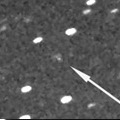
|
The condition in this apparition is bad. It keeps unobservable for a while. In the Southern Hemisphere, it will appear in the morning sky at 12.5 mag in February, then it keeps observable while fading gradually. In the Northern Hemisphere, it is not observable until when it fades down to 15 mag.
Date(TT) R.A. (2000) Decl. Delta r Elong. m1 Best Time(A, h)
Oct. 16 13 15.66 -2 11.8 2.727 1.741 6 14.2 4:42 (264,-13)
Oct. 23 13 33.06 -4 14.4 2.689 1.710 8 14.0 4:47 (268,-11)
|

|
It brightened up to 11.5 mag in July (July 18, Juan Jose Gonzalez). Now it is 12.7 mag (Sept. 10, Artyom Novichonok). Fading slowly. It will keep 14 mag until the end of 2010. It is observable in excellent condition in the Southern Hemisphere. It locates somewhat low in the Northern Hemisphere.
Date(TT) R.A. (2000) Decl. Delta r Elong. m1 Best Time(A, h)
Oct. 16 20 45.64 -30 19.9 2.396 2.794 103 14.1 19:07 ( 0, 25)
Oct. 23 20 51.23 -29 35.8 2.503 2.813 97 14.2 18:45 ( 0, 25)
|

|
Now it is bright as 14.4 mag (Oct. 10, Ken-ichi Kadota). It will be visible visually.
Date(TT) R.A. (2000) Decl. Delta r Elong. m1 Best Time(A, h)
Oct. 16 10 52.20 3 23.6 6.972 6.235 39 14.2 4:42 (280, 20)
Oct. 23 10 56.17 2 52.7 6.896 6.235 45 14.2 4:47 (285, 25)
|
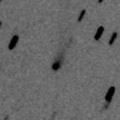
|
Now it is 14.4 mag, much brighter than originally expected (Oct. 17, S. Shurpakou). It keeps observable in good condition from autumn to next spring. It will brighten up to 13 mag and will be visible visually.
Date(TT) R.A. (2000) Decl. Delta r Elong. m1 Best Time(A, h)
Oct. 16 7 47.97 19 37.2 3.044 3.154 87 14.4 4:42 (302, 65)
Oct. 23 7 45.54 17 50.2 2.894 3.129 94 14.2 4:47 (322, 69)
|
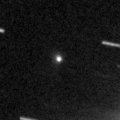
|
Now it is 13.3 mag, much brighter than expected and visible visually (Oct. 18, Juan Jose Gonzalez). In the Northern Hemisphere, it will be observable at 13-14 ag in good condition from autumn to winter. In the Southern Hemisphere, it will be unobservable until 2011 spring.
Date(TT) R.A. (2000) Decl. Delta r Elong. m1 Best Time(A, h)
Oct. 16 15 41.57 70 46.0 2.701 2.760 82 14.5 18:48 (156, 39)
Oct. 23 16 27.87 69 15.9 2.629 2.730 85 14.3 18:40 (155, 42)
|

|
It is already bright as 13.8 mag and visible visually (Sept. 10, Chris Wyatt). It will be observable at 13-14 mag for a long time from 2011 to 2012. It will be getting lower gradually in the evening sky after this. It will be unobservable in November in the Southern Hemisphere, or in December in the Northern Hemisphere.
Date(TT) R.A. (2000) Decl. Delta r Elong. m1 Best Time(A, h)
Oct. 16 20 15.68 -4 51.2 6.268 6.553 102 15.1 18:48 ( 5, 50)
Oct. 23 20 13.11 -5 17.2 6.363 6.522 94 15.1 18:40 ( 13, 49)
|
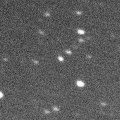
|
Now it is 14.8 mag (June 23, Hidetaka Sato). It keeps bright as 14-15 mag for a long time after this until 2013. It is not observable in the Northern Hemisphere. It will be low temporarily in November in the Southern Hemisphere. It must be bright, however, no observations have been reported since early July.
Date(TT) R.A. (2000) Decl. Delta r Elong. m1 Best Time(A, h)
Oct. 16 14 46.53 -49 52.8 7.001 6.332 44 15.2 18:48 ( 44,-23)
Oct. 23 14 51.49 -50 25.5 7.021 6.307 41 15.2 18:40 ( 45,-26)
|

|
Now it is bright as 14.2 mag and visible visually (Sept. 5, Sandor Szabo). It will be fading very slowly after this. In the Northern Hemisphere, it keeps observable for a long time until 2012 spring when it fades down to 17-18 mag.In the Southern Hemisphere, it will never be observable after this.
Date(TT) R.A. (2000) Decl. Delta r Elong. m1 Best Time(A, h)
Oct. 16 17 58.45 34 52.0 4.611 4.513 78 15.4 18:48 (101, 60)
Oct. 23 18 5.63 34 15.8 4.654 4.515 75 15.4 18:40 (100, 57)
|
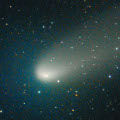
|
It reached up to 9.2 mag in March (Mar. 20, Marco Goiato). Now it is fading. It has already faded down to 14.8 mag (Sept. 1, Hidetaka Sato). It will be getting lower in the evening sky, and will be unobservable in November.
Date(TT) R.A. (2000) Decl. Delta r Elong. m1 Best Time(A, h)
Oct. 16 17 4.54 -21 0.1 3.080 2.633 54 15.9 18:48 ( 49, 16)
Oct. 23 17 16.60 -21 20.1 3.192 2.674 50 16.1 18:40 ( 50, 15)
|
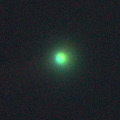
|
Observable in the evening sky in the Southern Hemisphere. Fading rapidly. It was bright as 7.7 mag on Aug. 17 (Chris Wyatt), but it has already faded down to 12.8 mag now (Sept. 27, Artyom Novichonok). It will keep observable while fading rapidly after this in the Southern Hemisphere. It is not observable in the Northern Hemisphere.
Date(TT) R.A. (2000) Decl. Delta r Elong. m1 Best Time(A, h)
Oct. 16 17 4.78 -29 18.8 1.725 1.427 55 15.9 18:48 ( 43, 10)
Oct. 23 17 30.77 -29 19.1 1.866 1.522 54 16.5 18:40 ( 42, 11)
|

|
Now it is 15.7 mag (Oct. 2, Ken-ichi Kadota). It is observable at 15.5 mag in good condition from autumn to winter. It locates somewhat low in the Southern Hemisphere.
Date(TT) R.A. (2000) Decl. Delta r Elong. m1 Best Time(A, h)
Oct. 16 6 37.87 21 19.0 1.659 2.126 103 16.0 4:42 (342, 76)
Oct. 23 6 44.97 22 32.9 1.587 2.129 108 15.9 4:40 ( 0, 78)
|

|
Now it is 16.5 mag (Oct. 5, Hidetaka Sato). It keeps 16 mag until the end of 2010. It keeps observable in good condition in the Southern Hemisphere. But it is not observable at all in the Northern Hemisphere.
Date(TT) R.A. (2000) Decl. Delta r Elong. m1 Best Time(A, h)
Oct. 16 8 17.16 -64 58.1 2.796 2.739 76 16.1 4:42 (348,-13)
Oct. 23 8 3.90 -68 53.8 2.766 2.742 78 16.1 4:47 (353,-15)
|

|
Now it is 16.9 mag (Sept. 25, K. Cernis, J. Zdanavicius). It will pass the perihelion on Nov. 25. In the Northern Hemisphere, it is observable until early November when it brightens up to 16 mag, and after mid December while fading from 16 mag. It will not be observable in the Southern Hemisphere.
Date(TT) R.A. (2000) Decl. Delta r Elong. m1 Best Time(A, h)
Oct. 16 9 31.61 16 36.4 0.995 1.033 62 16.5 4:42 (281, 44)
Oct. 23 10 14.87 11 16.4 0.887 0.914 57 16.2 4:47 (285, 39)
|
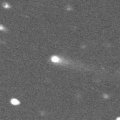
|
Now it is 17.2 mag (Oct. 6, Ken-ichi Kadota). It was observed at 16 mag from late 2009 to early 2010. It has already passed the perihelion, however, it tends to be brightest after the perihelion passage. It will be observable at 16 mag again in good condition from late 2010 to early 2011.
Date(TT) R.A. (2000) Decl. Delta r Elong. m1 Best Time(A, h)
Oct. 16 9 52.05 11 54.3 3.898 3.446 56 16.3 4:42 (282, 37)
Oct. 23 9 59.16 11 11.7 3.824 3.459 61 16.3 4:47 (288, 41)
|
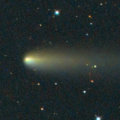
|
It brightened up to 9.5 mag in January (Jan. 13, Juan Jose Gonzalez). Now it is fading. It has already faded down to 15.4 mag (Sept. 9, Katsumi Yoshimoto). It will be fainter than 18 mag at the end of 2010. In the Northern Hemisphere, it keeps observable for a long time, although it will be getting lower gradually. It is not observable in the Southern Hemisphere.
Date(TT) R.A. (2000) Decl. Delta r Elong. m1 Best Time(A, h)
Oct. 16 16 17.37 36 51.7 4.926 4.531 61 16.6 18:48 (111, 40)
Oct. 23 16 26.15 35 56.9 5.004 4.587 59 16.7 18:40 (111, 38)
|

|
Now it is 16.8 mag (July 21, Hidetaka Sato). It keeps 16.5 mag until 2011 spring. It keeps observable in good condition in the Southern Hemisphere. But in the Northern Hemisphere, it locates very low in 2011 spring only.
Date(TT) R.A. (2000) Decl. Delta r Elong. m1 Best Time(A, h)
Oct. 16 11 35.13 -57 44.5 3.334 2.852 53 16.7 4:42 (325,-24)
Oct. 23 11 34.71 -58 37.0 3.321 2.847 53 16.7 4:47 (328,-20)
|
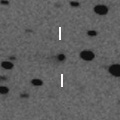
|
Now it is 16.9 mag (Oct. 9, Catalina Sky Survey). It keeps 17 mag for a long time from 2009 to 2012. It is observable in good condition in the Northern Hemisphere. It locates somewhat low in the Southern Hemisphere.
Date(TT) R.A. (2000) Decl. Delta r Elong. m1 Best Time(A, h)
Oct. 16 1 44.41 19 49.7 7.166 8.143 167 16.9 0:09 ( 0, 75)
Oct. 23 1 38.57 19 26.5 7.151 8.136 171 16.9 23:31 ( 0, 74)
|

|
Peculiar asteroid moving along a comet-like retrograde orbit. Now it is 17.8 mag (Oct. 6, Paul Camilleri). It brightens up to 16.5 mag in November. It is observable in excellent condition in the Southern Hemisphere. In the Northern Hemisphere, it will become lower rapidly, and will locate extremely low in November.
Date(TT) R.A. (2000) Decl. Delta r Elong. m1 Best Time(A, h)
Oct. 16 6 16.15 -14 3.2 1.464 1.957 103 17.6 4:40 ( 0, 41)
Oct. 23 5 56.86 -19 57.3 1.305 1.910 111 17.3 3:53 ( 0, 35)
|
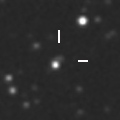
|
Now it is 17.3 mag (Oct. 6, Hidetaka Sato). It is expected to be 15 mag and will be observable in good condition in 2013. It is observable in good condition in the Northern Hemisphere, but not observable in the Southern Hemisphere now.
Date(TT) R.A. (2000) Decl. Delta r Elong. m1 Best Time(A, h)
Oct. 16 3 16.60 61 24.7 8.152 8.739 123 17.5 1:41 (180, 64)
Oct. 23 3 7.81 61 39.5 8.064 8.706 127 17.4 1:05 (180, 63)
|

|
Now it is 17.2 mag (Sept. 16, Catalina Sky Survey). It has already passed the perihelion, however, it tends to be brightest after the perihelion passage. In the Northern Hemisphere, it will be observable at 17.5 mag in good condition until the end of 2010. It locates extremely low in the Southern Hemisphere.
Date(TT) R.A. (2000) Decl. Delta r Elong. m1 Best Time(A, h)
Oct. 16 8 42.48 29 1.4 2.087 2.104 77 17.4 4:42 (271, 59)
Oct. 23 8 52.74 27 52.4 2.037 2.132 81 17.5 4:47 (277, 63)
|
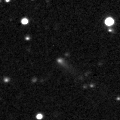
|
Now it is 17.3 mag (Oct. 2, Toru Yusa). It is observable at 17.5 mag in good condition from summer to autumn in the Northern Hemisphere. It locates somewhat low in the Southern Hemisphere.
Date(TT) R.A. (2000) Decl. Delta r Elong. m1 Best Time(A, h)
Oct. 16 0 59.00 31 28.2 0.904 1.862 156 17.5 23:19 ( 0, 86)
Oct. 23 0 57.88 29 33.7 0.914 1.874 158 17.5 22:50 ( 0, 84)
|

|
Now it is 17.3 mag (Sept. 25, Ken-ichi Kadota). It is fading. It will be fainter than 18 mag in November. It locates in excellent condition in the Southern Hemisphere, but it locates low in the Northern Hemisphere.
Date(TT) R.A. (2000) Decl. Delta r Elong. m1 Best Time(A, h)
Oct. 16 20 38.24 -32 2.5 2.921 3.261 100 17.7 18:59 ( 0, 23)
Oct. 23 20 42.61 -31 28.6 3.021 3.266 95 17.8 18:40 ( 1, 24)
|

|
Large Centaur-type asteroid. It keeps observable at 17-18 mag for a long time until 2013.
Date(TT) R.A. (2000) Decl. Delta r Elong. m1 Best Time(A, h)
Oct. 16 8 27.10 -18 12.8 6.752 6.515 72 17.8 4:42 (325, 29)
Oct. 23 8 27.39 -18 23.0 6.655 6.512 77 17.8 4:47 (333, 32)
|

|
New comet. Now it is 17.6 mag (Oct. 18, L. Buzzi, S. Foglia), but it will be fainter than 18 mag soon.
Date(TT) R.A. (2000) Decl. Delta r Elong. m1 Best Time(A, h)
Oct. 16 2 7.87 30 8.0 1.619 2.562 156 17.8 0:32 ( 0, 85)
Oct. 23 2 1.57 30 36.9 1.600 2.560 160 17.8 23:53 ( 0, 86)
|
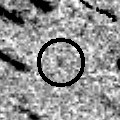
|
It was expected to be bright as 17-18 mag. But actually, it is so faint as 20.3 mag (Oct. 11, Giovanni Sostero and Ermesto Guido). However, it was observed as bright as 17 mag in 1998 and 2005. So it will brighten after the perihelion passage, and will be bright up to 17 mag in 2011-2012 season also in this apparition. In the Northern Hemisphere, it will be observable in good condition while fading gradually after 2011 summer. It is not observable after the perihelion passage in the Southern Hemisphere.
Date(TT) R.A. (2000) Decl. Delta r Elong. m1 Best Time(A, h)
Oct. 16 20 15.82 -34 53.9 2.340 2.633 95 20.2 18:48 ( 2, 20)
Oct. 23 20 20.83 -34 22.9 2.392 2.592 90 20.2 18:40 ( 6, 20)
|
|
![]()
 43P/Wolf-Harrington
43P/Wolf-Harrington C/2006 W3 ( Christensen )
C/2006 W3 ( Christensen ) 9P/Tempel 1
9P/Tempel 1 65P/Gunn
65P/Gunn 29P/Schwassmann-Wachmann 1
29P/Schwassmann-Wachmann 1 C/2010 B1 ( Cardinal )
C/2010 B1 ( Cardinal ) C/2009 Y1 ( Catalina )
C/2009 Y1 ( Catalina ) C/2006 S3 ( LONEOS )
C/2006 S3 ( LONEOS ) C/2009 F4 ( McNaught )
C/2009 F4 ( McNaught ) C/2008 FK75 ( Lemmon-Siding Spring )
C/2008 FK75 ( Lemmon-Siding Spring ) 81P/Wild 2
81P/Wild 2 2P/Encke
2P/Encke 240P/2010 P1 ( NEAT )
240P/2010 P1 ( NEAT ) C/2010 A4 ( Siding Spring )
C/2010 A4 ( Siding Spring ) (3200) Phaethon
(3200) Phaethon 203P/2008 R4 ( Korlevic )
203P/2008 R4 ( Korlevic ) C/2007 Q3 ( Siding Spring )
C/2007 Q3 ( Siding Spring ) C/2010 FB87 ( WISE-Garradd )
C/2010 FB87 ( WISE-Garradd ) C/2008 S3 ( Boattini )
C/2008 S3 ( Boattini ) 2009 YS6
2009 YS6 C/2010 S1 ( LINEAR )
C/2010 S1 ( LINEAR ) 241P/2010 P2 ( LINEAR )
241P/2010 P2 ( LINEAR ) 236P/2010 K1 ( LINEAR )
236P/2010 K1 ( LINEAR ) 215P/2009 B5 ( NEAT )
215P/2009 B5 ( NEAT ) 2008 YB3
2008 YB3 P/2010 U2 ( Hill )
P/2010 U2 ( Hill ) 164P/Christensen
164P/Christensen![]()























